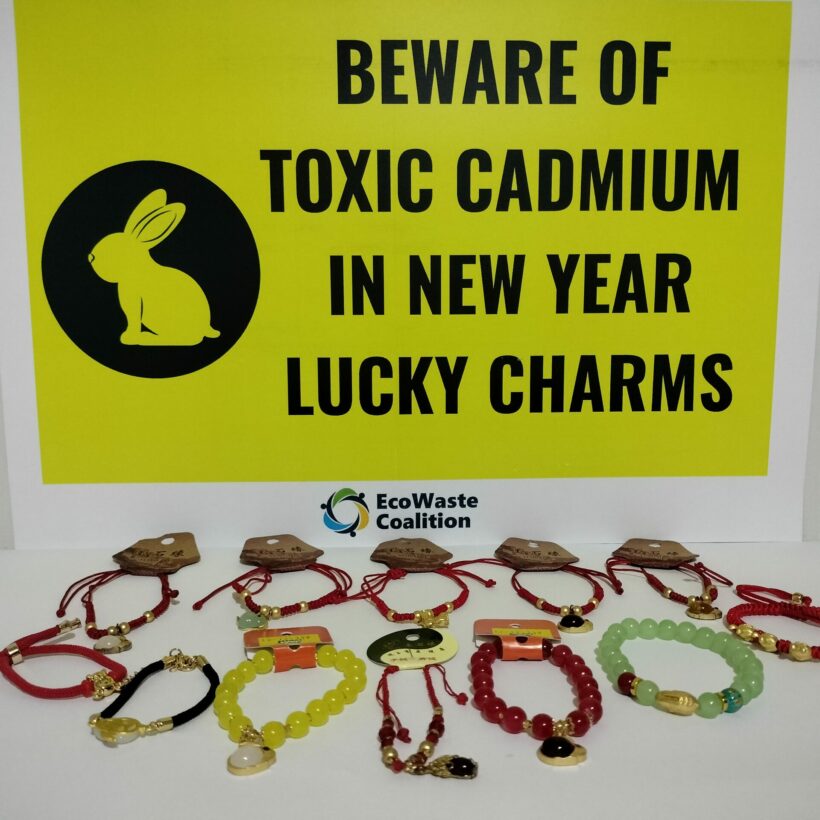EcoWaste Coalition pushes for chemical ingredient disclosure, insists consumers have the right to know.
10 January 2023, Quezon City. The toxics watchdog group EcoWaste Coalition has detected high levels of cadmium, a hazardous chemical, in lucky charm bracelets being sold in Quiapo, Manila ahead of the celebration of the Chinese Lunar New Year of the Water Rabbit on January 22.
In test buys conducted last week, the group purchased 15 bracelets adorned with a rabbit metal alloy from lucky charm retailers in the Quiapo district. The products are sold for P50 to P150 per piece.
The group then screened the rabbit ornament in each of the bracelets for cadmium content using an Olympus Vanta M Series X-Ray Fluorescence (XRF) analyzer. In the European Union (EU), cadmium in metal parts of jewelry and imitation jewelry cannot exceed the limit of 0.01 percent by weight or 100 parts per million (ppm).
Based on the XRF screening results, 12 of the 15 bracelets contained rabbit-inspired ornaments with cadmium content above the 100 ppm EU limit for cadmium in jewelry: seven had over 100,000 ppm, four had 19,690 to 78,200 ppm, and one had 553 ppm.
“We find the presence of cadmium in products marketed as charms for attracting good health, fortune and happiness very concerning as this substance is known to cause adverse health effects, including cancer,” said Aileen Lucero, National Coordinator, EcoWaste Coalition. “In fact, these pieces of jewelry would be illegal to sell in Europe because of their cadmium content.”
“Consumers should be forewarned that some lucky charms, which are often sold without any labeling information, may be laden with hazardous substances like cadmium,” she said. “Consumers may be exposed to cadmium through the skin or oral contact. Worst, a child may play with and accidentally ingest a cadmium-containing charm if the bracelet is broken or untied.”
A toxic metal with the symbol Cd and atomic number 48, cadmium and its compounds are listed in the Philippine Priority Chemical List and the World Health Organization’s list of “ten chemicals of major public health concern.”
According to the WHO, “cadmium exerts toxic effects on the kidneys as well as the skeletal and respiratory systems (and) is classified as a human carcinogen.” To reduce human exposure to cadmium, WHO has recommended, among other measures, “the elimination of the use of cadmium in products such as toys, jewelry and plastics.”
To protect consumer health, governments in the EU have issued notifications warning consumers of the risks of using cadmium-containing bracelets, earrings, rings and other jewelry, and have ordered importers or distributors to stop further sale, withdraw such products from the market or recall them from end users.
In notifications published in the Safety Gate, the EU rapid alert system for dangerous non-food products, governments warned that “cadmium is harmful to human health because it accumulates in the body, can damage the kidneys and bones and it may cause cancer.”
“The unrestricted sale of cadmium-laden jewelry in the local market is a public health concern. We urge concerned government regulators to take action in order to protect human health,” the EcoWaste Coalition said.
“The undisclosed cadmium in the analyzed jewelry is another example of how consumers are kept in the dark by manufacturers regarding hazardous substances in products being offered for sale in the market,” the group pointed out, adding “transparency in the chemicals that make up a product, as well as the hazards they pose to health and the environment, should be made mandatory in line with the consumers’ right to know.”
In lieu of lucky charms containing hazardous substances, the group advised the public to opt for tested ingredients or formulas for good health, fortune and happiness, including a healthy and non-toxic lifestyle, loving relationships, respect for nature, hard work, and kindness.
Reference:
https://chemical.emb.gov.ph/wp-content/uploads/2021/05/DAO-2021-08-CCO-Cadmium.pdf










